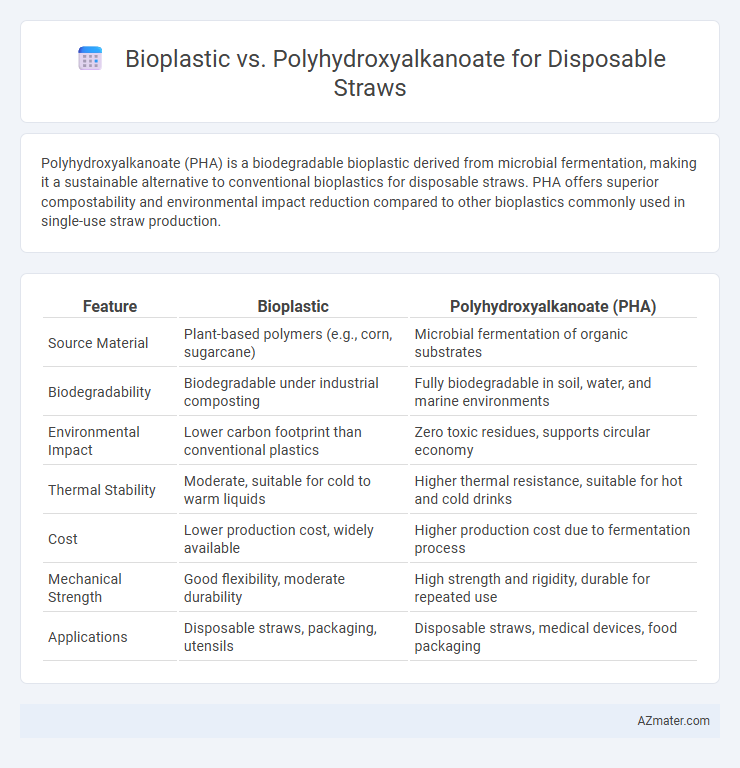Polyhydroxyalkanoate (PHA) is a biodegradable bioplastic derived from microbial fermentation, making it a sustainable alternative to conventional bioplastics for disposable straws. PHA offers superior compostability and environmental impact reduction compared to other bioplastics commonly used in single-use straw production.
Table of Comparison
| Feature | Bioplastic | Polyhydroxyalkanoate (PHA) |
|---|---|---|
| Source Material | Plant-based polymers (e.g., corn, sugarcane) | Microbial fermentation of organic substrates |
| Biodegradability | Biodegradable under industrial composting | Fully biodegradable in soil, water, and marine environments |
| Environmental Impact | Lower carbon footprint than conventional plastics | Zero toxic residues, supports circular economy |
| Thermal Stability | Moderate, suitable for cold to warm liquids | Higher thermal resistance, suitable for hot and cold drinks |
| Cost | Lower production cost, widely available | Higher production cost due to fermentation process |
| Mechanical Strength | Good flexibility, moderate durability | High strength and rigidity, durable for repeated use |
| Applications | Disposable straws, packaging, utensils | Disposable straws, medical devices, food packaging |
Introduction to Bioplastics and Polyhydroxyalkanoates
Bioplastics are a class of biodegradable polymers derived from renewable biomass sources, including starch, cellulose, and vegetable oils, offering an eco-friendly alternative to conventional plastics. Polyhydroxyalkanoates (PHAs) are a type of bioplastic produced by bacterial fermentation of sugars or lipids, known for their complete biodegradability and biocompatibility. In disposable straws, PHAs provide superior environmental benefits due to their natural decomposition without leaving toxic residues, distinguishing them from other bioplastics that may only be partially biodegradable.
Understanding Disposable Straw Materials
Bioplastic and polyhydroxyalkanoate (PHA) represent key materials in disposable straw manufacturing, each offering distinct environmental benefits and degradation profiles. Bioplastics, derived from renewable biomass like corn starch or sugarcane, provide reduced carbon footprints compared to petroleum-based plastics, but their compostability varies based on formulation. PHAs, a subset of bioplastics produced by bacterial fermentation, demonstrate superior biodegradability in marine and soil environments, making them a promising alternative for single-use straws and reducing plastic pollution.
Composition of Bioplastic vs Polyhydroxyalkanoate
Bioplastics are primarily composed of renewable biomass sources such as starch, cellulose, or polylactic acid (PLA), designed to reduce reliance on fossil fuels in disposable straw production. Polyhydroxyalkanoates (PHAs) are naturally synthesized polymers produced by microbial fermentation of organic substrates, offering complete biodegradability and enhanced mechanical properties. The distinct microbial origin and polymer structure of PHAs make them more environmentally sustainable and resistant compared to conventional plant-based bioplastics used in disposable straws.
Manufacturing Processes Compared
Bioplastics are typically produced from renewable biomass sources such as corn starch or sugarcane through polymerization or fermentation, involving energy-intensive extraction and refinement steps. Polyhydroxyalkanoates (PHAs), a subset of bioplastics, are synthesized directly by bacterial fermentation of organic substrates, allowing for a more sustainable and less chemically intensive manufacturing process. The microbial production of PHAs results in biodegradable polymers with tailored properties, providing an eco-friendly alternative with simpler downstream processing compared to conventional bioplastics used in disposable straws.
Biodegradability and Environmental Impact
Polyhydroxyalkanoates (PHAs) are a type of bioplastic known for their superior biodegradability, breaking down fully in marine environments within weeks compared to conventional bioplastics, which often require industrial composting. Disposable straws made from PHAs reduce microplastic pollution significantly, promoting a lower environmental footprint throughout their lifecycle. While standard bioplastics may still contribute to landfill waste and greenhouse gas emissions during degradation, PHAs offer a sustainable solution by converting organic waste into biodegradable polymers through microbial fermentation.
Performance and Durability in Real-World Use
Polyhydroxyalkanoates (PHAs) offer superior biodegradability and mechanical strength compared to conventional bioplastics, making them more reliable for disposable straws in real-world use. PHAs maintain structural integrity in both cold and warm liquids, ensuring consistent performance without degradation or deformation during typical consumption times. In contrast, many standard bioplastics can soften or break down prematurely, reducing durability and user experience in practical settings.
Cost Analysis and Market Availability
Bioplastic straws, derived mainly from starch or PLA, tend to have a lower production cost but face challenges in compostability and durability. Polyhydroxyalkanoate (PHA) straws, produced through microbial fermentation of sugars, incur higher manufacturing expenses due to complex bioprocessing but offer superior biodegradability and environmental benefits. Market availability for bioplastic straws is broader with widespread adoption, while PHA straws remain niche with limited suppliers, impacting pricing and distribution efficiency.
Regulatory and Certification Standards
Bioplastic disposable straws often face regulatory challenges due to inconsistent standards across regions, whereas Polyhydroxyalkanoate (PHA) straws benefit from certifications such as ASTM D6400 and EN 13432, validating their compostability and biodegradability. PHA straws align with stricter regulations emphasizing reduced environmental impact, including compliance with FDA food contact requirements and EU Packaging Directive mandates. Certification from organizations like the Biodegradable Products Institute (BPI) enhances PHA's market acceptance, ensuring it meets rigorous compostability and eco-toxicity criteria not always guaranteed by generic bioplastics.
Consumer Perceptions and Adoption
Consumer perceptions reveal growing preference for polyhydroxyalkanoate (PHA) over conventional bioplastics due to PHA's superior biodegradability and eco-friendly lifecycle. Market adoption of PHA-based disposable straws accelerates as environmentally conscious consumers prioritize products with clear compostable certifications and minimal plastic residue. Surveys indicate that transparency in sourcing and end-of-life disposal drives higher trust and willingness to switch from standard bioplastics to PHA alternatives.
Future Trends in Sustainable Straw Solutions
Polyhydroxyalkanoates (PHAs) represent a rapidly evolving category of bioplastics with superior biodegradability and marine safety compared to conventional bioplastics used for disposable straws. Innovations in microbial production and feedstock diversification are driving down costs, making PHAs increasingly viable for large-scale sustainable straw manufacturing. Market trends indicate a growing preference for PHAs due to their complete compostability and alignment with global plastic reduction policies targeting single-use items.

Infographic: Bioplastic vs Polyhydroxyalkanoate for Disposable straw
 azmater.com
azmater.com